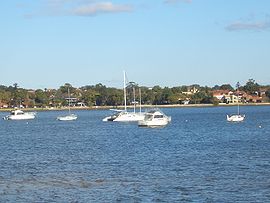Canada Bay, New South Wales: Difference between revisions
No edit summary |
Undid revision 273331055 by 24.36.34.30 (talk) |
||
| Line 35: | Line 35: | ||
The name Canada Bay honours a link between Australia and [[Canada]]. Following the [[Lower Canada Rebellion]] of 1837 to 1838, two Irish and 56 [[French Canadians|French Canadian]] rebels were deported to Australia. At the request of the local [[Catholic]] [[bishop]], they were brought to Sydney. Imprisoned at [[Longbottom Stockade]], the convicts broke stone for the construction of [[Parramatta Road]] and collected [[oyster]] shells for making [[Agricultural lime|lime]]. In 1842, the [[French Canadians]] were allowed to work outside the prison. Between 1843 and 1844, all received pardons and, except for two people who died and one (Joseph Marceau) who settled in [[Dapto, New South Wales|Dapto]] all returned to [[Canada]]. |
The name Canada Bay honours a link between Australia and [[Canada]]. Following the [[Lower Canada Rebellion]] of 1837 to 1838, two Irish and 56 [[French Canadians|French Canadian]] rebels were deported to Australia. At the request of the local [[Catholic]] [[bishop]], they were brought to Sydney. Imprisoned at [[Longbottom Stockade]], the convicts broke stone for the construction of [[Parramatta Road]] and collected [[oyster]] shells for making [[Agricultural lime|lime]]. In 1842, the [[French Canadians]] were allowed to work outside the prison. Between 1843 and 1844, all received pardons and, except for two people who died and one (Joseph Marceau) who settled in [[Dapto, New South Wales|Dapto]] all returned to [[Canada]]. |
||
Many parts of Canada Bay are a reminder of this history: Exile Bay, France Bay, Durham Street, Marceau Drive, Polding Street and Gipps Street. Bayview Park has a plaque that honours the exiles and marks the point of disembarkation. |
After the rebellions, the Australian [[Governor General]] and [[Lord High Commissioner]] to Canada recommended that [[United Kingdom of Great Britain and Ireland|Britain]] grant responsible self government to the [[Union of Upper and Lower Canada]]. In the 1850s, the Australian colonies achieved responsible government and [[parliamentary democracy]]. Many parts of Canada Bay are a reminder of this history: Exile Bay, France Bay, Durham Street, Marceau Drive, Polding Street and Gipps Street. Bayview Park has a plaque that honours the exiles and marks the point of disembarkation. |
||
The [[City of Canada Bay]] was formed in December 2000, by the merger of [[Concord, New South Wales|Concord]] and [[Drummoyne, New South Wales|Drummoyne]] councils. |
The [[City of Canada Bay]] was formed in December 2000, by the merger of [[Concord, New South Wales|Concord]] and [[Drummoyne, New South Wales|Drummoyne]] councils. |
||
Revision as of 02:47, 26 February 2009
- For the For the local government area see City of Canada Bay.
| Canada Bay Sydney, New South Wales | |||||||||||||||
|---|---|---|---|---|---|---|---|---|---|---|---|---|---|---|---|
 Canada Bay | |||||||||||||||
| Population | 1,308 (SAL 2021)[1] | ||||||||||||||
| Postcode(s) | 2046 | ||||||||||||||
| Location | 11 km (7 mi) west of Sydney CBD | ||||||||||||||
| LGA(s) | City of Canada Bay | ||||||||||||||
| State electorate(s) | Drummoyne | ||||||||||||||
| Federal division(s) | Lowe | ||||||||||||||
| |||||||||||||||
Canada Bay is a suburb in the inner-west of Sydney, in the state of New South Wales, Australia. Canada Bay is located 11 kilometres west of the Sydney central business district, in the local government area of City of Canada Bay.
Canada Bay is also a bay on Parramatta River between Concord and Five Dock. The suburb of Canada Bay sits on the southern shore and is bordered by the suburbs of Burwood and Croydon. The City of Canada Bay takes its name from the bay but its administrative centre is located in the suburb of Drummoyne.
History
The name Canada Bay honours a link between Australia and Canada. Following the Lower Canada Rebellion of 1837 to 1838, two Irish and 56 French Canadian rebels were deported to Australia. At the request of the local Catholic bishop, they were brought to Sydney. Imprisoned at Longbottom Stockade, the convicts broke stone for the construction of Parramatta Road and collected oyster shells for making lime. In 1842, the French Canadians were allowed to work outside the prison. Between 1843 and 1844, all received pardons and, except for two people who died and one (Joseph Marceau) who settled in Dapto all returned to Canada.
After the rebellions, the Australian Governor General and Lord High Commissioner to Canada recommended that Britain grant responsible self government to the Union of Upper and Lower Canada. In the 1850s, the Australian colonies achieved responsible government and parliamentary democracy. Many parts of Canada Bay are a reminder of this history: Exile Bay, France Bay, Durham Street, Marceau Drive, Polding Street and Gipps Street. Bayview Park has a plaque that honours the exiles and marks the point of disembarkation.
The City of Canada Bay was formed in December 2000, by the merger of Concord and Drummoyne councils.
See also
External links
- City of Canada Bay website
- Canada Bay and the Canadian Exiles
- Canada in Australia: Canadian Department of Foreign and International Affairs
Template:Mapit-AUS-suburbscale
- ^ Australian Bureau of Statistics (28 June 2022). "Canada Bay (suburb and locality)". Australian Census 2021 QuickStats. Retrieved 28 June 2022.
